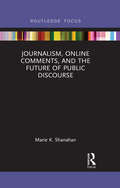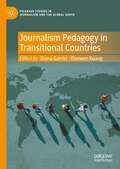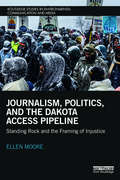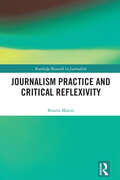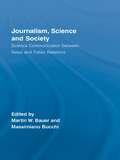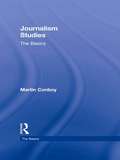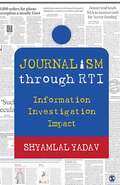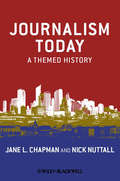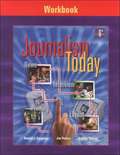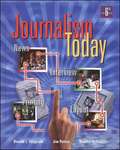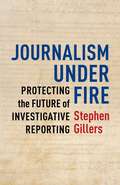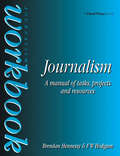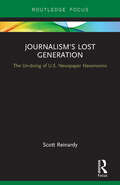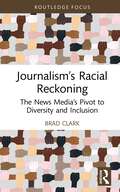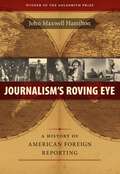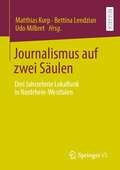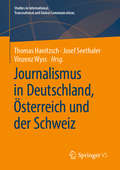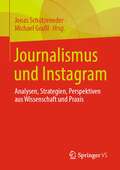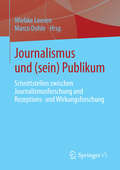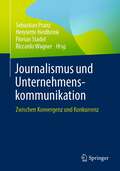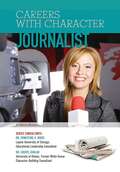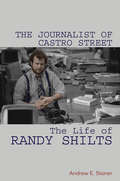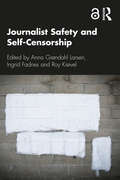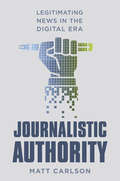- Table View
- List View
Journalism, Online Comments, and the Future of Public Discourse
by Marie K. ShanahanComments on digital news stories and on social media play an increasingly important role in public discourse as more citizens communicate through online networks. The reasons for eliminating comments on news stories are plentiful. Off-topic posts and toxic commentary have been shown to undermine legitimate news reporting. Yet the proliferation of digital communication technology has revolutionized the setting for democratic participation. The digital exchange of ideas and opinions is now a vital component of the democratic landscape. Marie K. Shanahan's book argues that public digital discourse is crucial component of modern democracy—one that journalists must stop treating with indifference or detachment—and for news organizations to use journalistic rigor and better design to add value to citizens’ comments above the social layer. Through original interviews, anecdotes, field observations and summaries of research literature, Shanahan explains the obstacles of digital discourse as well as its promises for journalists in the digital age.
Journalism Pedagogy in Transitional Countries (Palgrave Studies in Journalism and the Global South)
by Diana Garrisi Xianwen KuangThis book explains what it means to teach journalism in countries with limited media freedom in the post-pandemic era. It digs into the social and historical factors underpinning the development of journalism university degrees and courses in a selection of illustrative case studies taken from Africa, Asia, Europe, and Latin America. This work assesses both the limitations and creative opportunities arising from teaching journalism under constraints. Topics include but are not limited to: the application of Western theoretical frameworks in new transnational universities in China; the historical and political roots of the gap between industry and academia in Slovenia; ideological clashes and classism in higher education in the Arab region; scholar-activism in Turkey; decolonizing journalism curricula in South Asia; journalism students as research partners in the Philippines; and the repression of the student press in Mexico. Although this book focuses broadly on the Global South, the theoretical and practical implications of its findings and related discussion will inform the challenges facing journalism training today as a whole.
Journalism, Politics, and the Dakota Access Pipeline: Standing Rock and the Framing of Injustice (Routledge Studies in Environmental Communication and Media)
by Ellen MooreThis book explores tensions surrounding news media coverage of Indigenous environmental justice issues, identifying them as a fruitful lens through which to examine the political economy of journalism, American history, human rights, and contemporary U.S. politics. The book begins by evaluating contemporary American journalism through the lens of "deep media", focusing especially on the relationship between the drive for profit, professional journalism, and coverage of environmental justice issues. It then presents the results of a framing analysis of the Standing Rock movement (#NODAPL) coverage by news outlets in the USA and Canada. These findings are complemented by interviews with the Standing Rock Sioux Tribe, whose members provided their perspectives on the media and the pipeline. The discussion expands by considering the findings in light of current U.S. politics, including a Trump presidency that employs "law and order" rhetoric regarding people of color and that often subjects environmental issues to an economic "cost-benefit" analysis. The book concludes by considering the role of social media in the era of "Big Oil" and growing Indigenous resistance and power. Examining the complex interplay between social media, traditional journalism, and environmental justice issues, Journalism, Politics, and the Dakota Access Pipeline: Standing Rock and the Framing of Injustice will be of great interest to students and scholars of environmental communication, critical political economy, and journalism studies more broadly.
Journalism Practice and Critical Reflexivity (Routledge Research in Journalism)
by Bonita MasonJournalism Practice and Critical Reflexivity is a theoretical- and practice-based response to the crisis of mission and credibility in journalism studies that is heightened by online and social media. It describes, analyses and offers new approaches and models for critically reflexive journalism research, practice and education. With specific theoretical and conceptual approaches employed, such as Pierre Bourdieu’s reflexive sociology along with the analytical, practice-based, reflective and narrative techniques of Donald Schön and autoethnography, this book provides possible responses to these crises of purpose and legitimacy, and to transformation, in Western corporate journalism. With journalists working in mainstream media under increasing pressure, the book considers the possibility of either slowing journalism down or having elements of a more reflexive journalism practice set alongside other routine practices. It proposes reciprocity as a core value to guide much investigative and news journalism. Scholars and practitioners of journalism, researchers and post-graduate students interested in journalism, critical reflexivity and reflective practice in relevant disciplines can apply the concepts and techniques of critical reflexivity in their own research or teaching. Journalists, criminologists and others concerned with Indigenous deaths in custody, prisons, the institutional duty of care, social and/or legal justice and effective government administration will also find the study rewarding.
Journalism Practice and Critical Reflexivity (Routledge Research in Journalism)
by Bonita MasonJournalism Practice and Critical Reflexivity is a theoretical- and practice-based response to the crisis of mission and credibility in journalism studies that is heightened by online and social media. It describes, analyses and offers new approaches and models for critically reflexive journalism research, practice and education. With specific theoretical and conceptual approaches employed, such as Pierre Bourdieu’s reflexive sociology along with the analytical, practice-based, reflective and narrative techniques of Donald Schön and autoethnography, this book provides possible responses to these crises of purpose and legitimacy, and to transformation, in Western corporate journalism. With journalists working in mainstream media under increasing pressure, the book considers the possibility of either slowing journalism down or having elements of a more reflexive journalism practice set alongside other routine practices. It proposes reciprocity as a core value to guide much investigative and news journalism.Scholars and practitioners of journalism, researchers and post-graduate students interested in journalism, critical reflexivity and reflective practice in relevant disciplines can apply the concepts and techniques of critical reflexivity in their own research or teaching. Journalists, criminologists and others concerned with Indigenous deaths in custody, prisons, the institutional duty of care, social and/or legal justice and effective government administration will also find the study rewarding.
Journalism, Science and Society: Science Communication between News and Public Relations (Routledge Studies in Science, Technology and Society #Vol. 7)
by Martin W. Bauer Massimiano BucchiAnalyzing the role of journalists in science communication, this book presents a perspective on how this is going to evolve in the twenty-first century. The book takes three distinct perspectives on this interesting subject. Firstly, science journalists reflect on their ‘operating rules’ (science news values and news making routines). Secondly, a brief history of science journalism puts things into context, characterising the changing output of science writing in newspapers over time. Finally, the book invites several international journalists or communication scholars to comment on these observations thereby opening the global perspective. This unique project will interest a range of readers including science communication students, media studies scholars, professionals working in science communication and journalists.
Journalism Studies: The Basics (The Basics)
by Martin ConboyJournalism Studies: The Basics provides an introductory overview of the emerging field of Journalism Studies, discussing key issues and contemporary debates. Drawing on Conboy’s extensive experience in the field, the changing nature of journalism and its future directions are addressed, through chapters covering: the history and development of Journalism Studies how journalists are created through training and education changing research methods and processes in journalism the impact of the ‘end product’ in wider society global perspectives on journalism technology and the future of the discipline. Situated within a fast growing and dynamic field of study, this engaging introduction will be valuable reading for students of journalism, media and communication, along with those seeking to develop a broader understanding of contemporary journalism.
Journalism through RTI: Information Investigation Impact
by Shyamlal YadavHow RTI changed the face of investigative journalism in India, forever… The RTI Act has helped investigative journalism in getting information that otherwise would have been almost impossible to unearth despite legal provisions. Using the storyline approach, the author, through his own experiences, unravels how news was collected through persistent efforts using RTI, how the stories evolved, and how the subject was followed up keeping an eye on the rightful impact. Hence the emphasis is less on theory and more on practical aspects, making the book ‘a story behind India’s biggest news stories’.
Journalism Today: A Themed History
by Jane L. Chapman Nick NuttallJournalism Today: A Themed History provides a cultural approach to journalism's history through the exploration of overarching concepts, as opposed to a typical chronological overview. Rich with illuminating stories and biographies of key figures, it sheds new light on the relationship between the press and society and how each has shaped the other. Thematic study of the history of journalism, examining the role of journalism in democracy, the influence of new technology, the challenge of balancing ethical values, and the role of the audience Charts the influence of the historical press for today’s news in print, broadcast, and new media Situates journalism in a rich cultural context with lively examples and case studies that bring the subject alive for contemporary readers Provides a comparative analysis of American, British, and international journalism Helpful feature boxes on important figures and case studies enhance student understanding of the development of journalism and news as we know it today, providing a convenient springboard for follow-up work.
Journalism Today: Workbook (Sixth Edition)
by Donald L. Ferguson Jim Patten Bradley WilsonJournalism Today provides students with the instruction and tools to develop skills in the production of print and electronic journalistic media. Reading, writing, speaking, listening, viewing, analyzing, technology, planning, and production skills are integrated throughout the lessons. Features include writing assignments with specific strategies to help students work through each step in the writing process; examples from student newspapers and yearbooks throughout the country; journalists' testimonies about their career paths with advice for students interested in a career in journalism; and a professional guide to consistency in punctuation, abbreviation, and capitalization in their school publications.
Journalism Today (6th edition)
by Donald L. Ferguson Jim Patten Bradley WilsonDiscusses the history and responsibilities of the Media, the gathering, writing, and presentation of news, and the future of journalism as technology changes.
Journalism Under Fire: Protecting the Future of Investigative Reporting (Columbia Journalism Review Books)
by Stephen GillersA healthy democracy requires vigorous, uncompromising investigative journalism. But today the free press faces a daunting set of challenges: in the face of harsh criticism from powerful politicians and the threat of lawsuits from wealthy individuals, media institutions are confronted by an uncertain financial future and stymied by a judicial philosophy that takes a narrow view of the protections that the Constitution affords reporters. In Journalism Under Fire, Stephen Gillers proposes a bold set of legal and policy changes that can overcome these obstacles to protect and support the work of journalists.Gillers argues that law and public policy must strengthen the freedom of the press, including protection for news gathering and confidential sources. He analyzes the First Amendment’s Press Clause, drawing on older Supreme Court cases and recent dissenting opinions to argue for greater press freedom than the Supreme Court is today willing to recognize. Beyond the First Amendment, Journalism Under Fire advocates policies that facilitate and support the free press as a public good. Gillers proposes legislation to create a publicly funded National Endowment for Investigative Reporting, modeled on the national endowments for the arts and for the humanities; improvements to the Freedom of Information Act; and a national anti-SLAPP law, a statute to protect media organizations from frivolous lawsuits, to help journalists and the press defend themselves in court. Gillers weaves together questions of journalistic practice, law, and policy into a program that can ensure a future for investigative reporting and its role in our democracy.
Journalism Workbook: A Manual of Tasks, Projects and Resources (Focal Press Journalism Ser.)
by Brendan Hennessy F W HodgsonUsing practical assignments, the authors take each area of journalism, and demonstrate the world which awaits journalists in the early years of their careers. Each of the assignments spins off a number of tasks which are presented to the reader in the form of briefings, and can be used as a basis for further study. Notes and references are provided with each of the tasks to guide the student and help them understand fully each area of practice. There are also exercises on page planning and design. Workshop projects and study programmes outline ways in which students and trainees in groups or singly can analyse newspaper content, build up readership profiles and consider different methods of practice, social and political attitudes to the media, press regulations and press economics. This book will also be an invaluable purchase for students using distance learning packs.
Journalism’s Lost Generation: The Un-doing of U.S. Newspaper Newsrooms
by Scott ReinardyJournalism’s Lost Generation discusses how the changes in the industry not only indicate a newspaper crisis, but also a crisis of local communities, a loss of professional skills, and a void in institutional and community knowledge emanating from newsrooms. Reinardy’s thorough and opinionated take on the transition seen in newspaper newsrooms is coupled with an examination of the journalism industry today. This text also provides a broad view of the newspaper journalism being produced today, and those who are attempting to produce it.
Journalism’s Racial Reckoning: The News Media’s Pivot to Diversity and Inclusion (Routledge Focus on Journalism Studies)
by Brad ClarkThis book addresses endemic issues of racism in news media at what is a critical moment in time, as journalists around the world speak out en masse against the prejudice and inequality in the industry. As the events of 2020 – the death of George Floyd, the rise in prominence of the Black Lives Matter movement – have drawn new and focused attention to inequality, white supremacy, and systemic racism, including in the media, this volume chronicles this racial reckoning, revisiting and examining the issues that it has raised. The author analyses media output by racialized and Indigenous journalists, identifying the racial make-up of newsrooms; the dominance of white perspectives in news coverage; interpretations of ethics downplaying systemic racism and bias; ignorance of racist history in editorial decisions and news content; and diversity and inclusion measures. The actions taken by news organizations in response to the reckoning are also detailed and placed in the context of existing race and media scholarship, to offer emerging strategies to address journalism’s longstanding issues with racism in news content and newsrooms. Grounding the interplay between news media and race within this pivotal moment in history, this text will be an important resource for students and scholars of journalism, journalism ethics, sociology, cultural studies, organizational studies, media and communication studies.
Journalism's Roving Eye: A History of American Foreign Reporting (From Our Own Correspondent)
by John Maxwell HamiltonIn all of journalism, nowhere are the stakes higher than in foreign news-gathering. For media owners, it is the most difficult type of reporting to finance; for editors, the hardest to oversee. Correspondents, roaming large swaths of the planet, must acquire expertise that home-based reporters take for granted -- facility with the local language, for instance, or an understanding of local cultures. Adding further to the challenges, they must put news of the world in context for an audience with little experience and often limited interest in foreign affairs -- a task made all the more daunting because of the consequence to national security. In Journalism's Roving Eye, John Maxwell Hamilton -- a historian and former foreign correspondent -- provides a sweeping and definitive history of American foreign news reporting from its inception to the present day and chronicles the economic and technological advances that have influenced overseas coverage, as well as the cavalcade of colorful personalities who shaped readers' perceptions of the world across two centuries.From the colonial era -- when newspaper printers hustled down to wharfs to collect mail and periodicals from incoming ships -- to the ongoing multimedia press coverage of the Iraq War, Hamilton explores journalism's constant -- and not always successful -- efforts at "dishing the foreign news," as James Gordon Bennett put it in the mid-nineteenth century to describe his approach in the New York Herald. He details the highly partisan coverage of the French Revolution, the early emergence of "special correspondents" and the challenges of organizing their efforts, the profound impact of the non-yellow press in the run-up to the Spanish-American War, the increasingly sophisticated machinery of propaganda and censorship that surfaced during World War I, and the "golden age" of foreign correspondence during the interwar period, when outlets for foreign news swelled and a large number of experienced, independent journalists circled the globe. From the Nazis' intimidation of reporters to the ways in which American popular opinion shaped coverage of Communist revolution and the Vietnam War, Hamilton covers every aspect of delivering foreign news to American doorsteps.Along the way, Hamilton singles out a fascinating cast of characters, among them Victor Lawson, the overlooked proprietor of the Chicago Daily News, who pioneered the concept of a foreign news service geared to American interests; Henry Morton Stanley, one of the first reporters to generate news on his own with his 1871 expedition to East Africa to "find Livingstone"; and Jack Belden, a forgotten brooding figure who exemplified the best in combat reporting. Hamilton details the experiences of correspondents, editors, owners, publishers, and network executives, as well as the political leaders who made the news and the technicians who invented ways to transmit it. Their stories bring the narrative to life in arresting detail and make this an indispensable book for anyone wanting to understand the evolution of foreign news-gathering. Amid the steep drop in the number of correspondents stationed abroad and the recent decline of the newspaper industry, many fear that foreign reporting will soon no longer exist. But as Hamilton shows in this magisterial work, traditional correspondence survives alongside a new type of reporting. Journalism's Roving Eye offers a keen understanding of the vicissitudes in foreign news, an understanding imperative to better seeing what lies ahead.
Journalismus auf zwei Säulen: Drei Jahrzehnte Lokalfunk in Nordrhein-Westfalen
by Matthias Kurp Bettina Lendzian Udo MilbretDreißig Jahre nach dem Start des Lokalfunks in Nordrhein-Westfalen bietet das Buch Rückblick und Ausblick zugleich. In dem Sammelband finden sich Beiträge von ehemaligen und aktuellen Verantwortlichen, also von Autorinnen und Autoren aus Medienpolitik, ‐wirtschaft und ‐aufsicht, aber auch aus den Bereichen Programm und Wissenschaft. Dabei geht es um eine kritische Bestandsaufnahme und um Szenarien, wie der Lokalfunk in Nordrhein‐Westfalen in der aktuellen publizistischen Breite und Vielfalt weiterentwickelt werden kann.Hinzu kommen eine Chronik sowie Übersichten mit Daten zu Veranstaltergemeinschaften, Betriebsgesellschaften und Chefredakteurinnen oder Chefredakteuren aller Lokalfunkstationen in Nordrhein-Westfalen.
Journalismus in Deutschland, Österreich und der Schweiz (Studies in International, Transnational and Global Communications)
by Thomas Hanitzsch Josef Seethaler Vinzenz WyssDer Band liefert eine Zustandsbeschreibung des Journalismus in einer Zeit, in der Medieninstitutionen ökonomisch unter Druck stehen und journalistische Autoritäten zunehmend hinterfragt werden. Das Buch berichtet Ergebnisse einer Befragung von über 2500 Journalist*innen in Deutschland, Österreich und der Schweiz. Im Zentrum stehen die soziodemografischen Profile der Journalist*innen, die Anstellungsverhältnisse und Tätigkeitsbereiche, ihre beruflichen Rollenverständnisse und ethischen Orientierungen, ihr Vertrauen in gesellschaftliche Institutionen sowie die Wahrnehmung von redaktioneller Autonomie und Einflüssen auf ihre Arbeit.
Journalismus und Instagram: Analysen, Strategien, Perspektiven aus Wissenschaft und Praxis
by Jonas Schützeneder Michael GraßlInstagram ist auf dem Weg, der wichtigste Social-Media-Kanal der Welt zu werden. Dieser Sammelband geht die Forschungslücke im Zusammenspiel von Journalismus und Instagram systematisch und facettenreich an. Autor*innen aus Wissenschaft und Praxis liefern dafür vielfältige Analysen, Strategien und Perspektiven. Wissenschaftliche Verortungen werden ergänzt durch mehrere Fallstudien rund um die journalistische Instagram-Nutzung. Gleichzeitig ermöglichen Praktiker*innen Einblicke auf tägliche Herausforderungen und die Folgen, nicht nur für die Journalist*innen-Ausbildung im Bereich Social Media.
Journalismus und (sein) Publikum
by Wiebke Loosen Marco DohleDas Bild von der verschwimmenden Grenze zwischen Kommunikator und Rezipient ist das Leitmotiv zur Charakterisierung der gewandelten Kommunikationsverhältnisse im Onlinezeitalter. Die akademische Trennung zwischen Journalismusforschung und Rezeptions- und Wirkungsforschung erschwert es, die damit verbundenen Entwicklungen und Phänomene adäquat zu beschreiben und zu analysieren. Dieser Band versammelt daher Beiträge, die sich mit den Schnittstellen zwischen Journalismusforschung und Rezeptions- und Wirkungsforschung auseinandersetzten und Theorien, Ansätze und Methoden aus beiden Feldern miteinander abgleichen. Im Mittelpunkt steht dabei die Frage, wie eine derart integrierende Perspektive dazu beitragen kann, die gewandelten gesellschaftlichen Kommunikationsverhältnisse theoretisch und empirisch in den Griff zu bekommen.
Journalismus und Unternehmenskommunikation: Zwischen Konvergenz und Konkurrenz
by Sebastian Pranz Henriette Heidbrink Florian Stadel Riccardo WagnerObwohl sich Journalismus und Unternehmenskommunikation in Funktion und Selbstverständnis immer noch deutlich voneinander unterscheiden, hat die digitale Transformation für eine zunehmende Konvergenz beider Berufsfelder gesorgt. Die Frage, wie und unter welchen Voraussetzungen Öffentlichkeit erzeugt wird, stellt sich angesichts eines tiefgreifenden Medienwandels mit zunehmender Dringlichkeit. Dieses Buch beschreibt das Spannungsverhältnis zwischen beiden Feldern mit Blick auf technologische, ökonomische und praktische Aspekte. Expert*innen aus Journalismus, Unternehmen und Forschung erläutern – wissenschaftlich fundiert und anhand von zahlreichen Praxisbeispielen –, wie sich das neue Miteinander gestaltet: von den jeweils berufsspezifischen Umbrüchen über Wissensvermittlung, -transfer und Netzwerkarbeit bis hin zu neuen Businessmodellen und -strategien für beide Berufsfelder.Ein Buch für Journalist*innen, journalistische Unternehmer*innen, Kommunikationsverantwortliche in Unternehmen, Studierende und praxisorientierte Wissenschaftler*innen.Mit Beiträgen von:• Dr. Matthias Albisser, Hochschule Luzern• Prof. Dr. Christopher Buschow, Bauhaus-Universität Weimar• Prof. Dr. Matthias Degen, Westfälische Hochschule• Prof. Dr. Alexander Godulla, Universität Leipzig• M.A. Benjamin Held, Westfälische Hochschule• Dr. Constanze Jecker, Hochschule Luzern• Prof. Dr. Florian Meißner, Hochschule Macromedia• M.A. Megan Neumann, Ostfalia Hochschule für angewandte Wissenschaften• Prof. Dr. Marc-Christian Ollrog, Ostfalia Hochschule für angewandte Wissenschaften• Rosanna Planer, Universität Leipzig• Prof. Dr. Lars Rademacher, Hochschule Darmstadt• Prof. Dr. Christoph Raetzsch, School of Communication and Culture• Dr. Jonas Schützeneder, Katholische Universität Eichstätt-Ingolstadt• Prof. Dr. René Seidenglanz, Quadriga Hochschule• M.A. Hauke Serger, Bauhaus-Universität Weimar• Dr. Klaus Spachmann, Universität Hohenheim• B.A. Karoline Steinbock, Ostfalia Hochschule für angewandte Wissenschaften• M.A. Maike Suhr, Bauhaus-Universität Weimar• Dr. Daniel Vogel, fög – Forschungszentrum Öffentlichkeit und Gesellschaft• Prof. Dr. Stefan Weinacht, Westfälische Hochschule• Prof. Dr. Cornelia Wolf, Universität Leipzig
Journalist (Careers With Character)
by Sherry BonniceFind out what it takes to be a journalist with character... Journalists have many career areas from which to choose. Some of the most common include: *News reporter; *Editor; *Investigative reporter; *Magazine writer; *Freelance writer; and *Foreign correspondent. Most employers in this field require experience as well as education, and equally important is character. Without the core qualities of a good character, journalists' work does not benefit those it serves. That's why journalists need: Integrity to report a story accurately... Compassion and respect for human beings who need their stories told... And courage to face dangerous situations and withstand pressure. Journalists have the power to fight injustice, ignorance, poverty, and prejudice. Journalist will show you how.
The Journalist of Castro Street: The Life of Randy Shilts
by Andrew E StonerAs the acclaimed author of And the Band Played On, Randy Shilts became the country's most recognized voice on the HIV/AIDS epidemic. His success emerged from a relentless work ethic and strong belief in the power of journalism to help mainstream society understand not just the rising tide of HIV/AIDS but gay culture and liberation.In-depth and dramatic, Andrew E. Stoner's biography follows the remarkable life of the brash, pioneering journalist. Shilts's reporting on AIDS in San Francisco broke barriers even as other gay writers and activists ridiculed his overtures to the mainstream and labeled him a traitor to the movement, charges the combative Shilts forcefully answered. Behind the scenes, Shilts overcame career-threatening struggles with alcohol and substance abuse to achieve the notoriety he had always sought, while the HIV infection he had purposely kept hidden began to take his life.Filled with new insights and fascinating detail, The Journalist of Castro Street reveals the historic work and passionate humanity of the legendary investigative reporter and author.
Journalist Safety and Self-Censorship
by Anna Gr Ingrid Fadnes Roy KrThis book explores the relationship between the safety of journalists and self-censorship practices around the world, including local case studies and regional and international perspectives. Bringing together scholars and practitioners from around the globe, Journalist Safety and Self-Censorship provides new and updated insights into patterns of self-censorship and free speech, focusing on a variety of factors that affect these issues, including surveillance, legislation, threats, violent conflict, gender-related stereotypes, digitisation and social media. The contributions examine topics such as trauma, risk and self-censorship among journalists in different regions of the world, including Central America, Estonia, Turkey, Uganda and Pakistan. The book also provides conceptual clarity to the notion of journalist self-censorship, and explores the question of how self-censorship may be studied empirically.Combining both theoretical and practical knowledge, this collection serves as a much-needed resource for any academic, student of journalism, practicing journalist, or NGO working on issues of journalism, safety, free speech and censorship.
Journalistic Authority: Legitimating News in the Digital Era
by Matt CarlsonWhen we encounter a news story, why do we accept its version of events? Why do we even recognize it as news? A complicated set of cultural, structural, and technological relationships inform this interaction, and Journalistic Authority provides a relational theory for explaining how journalists attain authority. The book argues that authority is not a thing to be possessed or lost, but a relationship arising in the connections between those laying claim to being an authority and those who assent to it. Matt Carlson examines the practices journalists use to legitimate their work: professional orientation, development of specific news forms, and the personal narratives they circulate to support a privileged social place. He then considers journalists' relationships with the audiences, sources, technologies, and critics that shape journalistic authority in the contemporary media environment. Carlson argues that journalistic authority is always the product of complex and variable relationships. Journalistic Authority weaves together journalists’ relationships with their audiences, sources, technologies, and critics to present a new model for understanding journalism while advocating for practices we need in an age of fake news and shifting norms.
